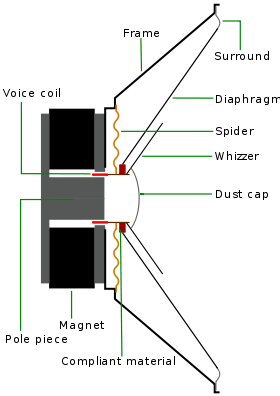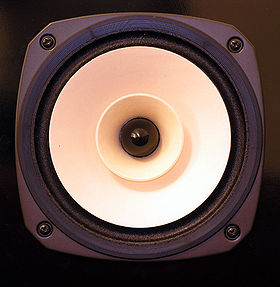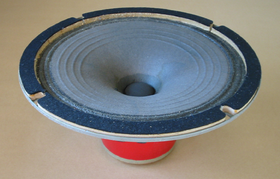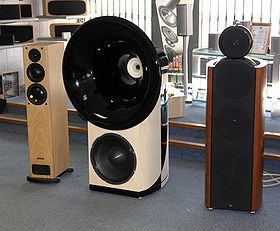
Full-range
Encyclopedia




Loudspeaker
A loudspeaker is an electroacoustic transducer that produces sound in response to an electrical audio signal input. Non-electrical loudspeakers were developed as accessories to telephone systems, but electronic amplification by vacuum tube made loudspeakers more generally useful...
drive unit is defined as a driver which reproduces as much of the audible frequency range as possible, within the limitations imposed by the physical constraints of a specific design. Frequency range is of these drives is maximized through the use of a whizzer cone and other means. Most single driver systems, such as those in radios, or small computer speaker
Computer speaker
Computer speakers, or multimedia speakers, are speakers external to a computer, that disable the lower fidelity built-in speaker. They often have a low-power internal amplifier. The standard audio connection is a 3.5 mm stereo jack plug often color-coded lime green for computer sound cards...
designs, cannot reproduce the entire audio range.
Typical designs
Typically, a full-range drive unit consists of a single driver element, or voice coilVoice coil
A voice coil is the coil of wire attached to the apex of a loudspeaker cone. It provides the motive force to the cone by the reaction of a magnetic field to the current passing through it...
, used to move and control a diaphragm. Often the cone structure includes optimizations to enhance high-frequency performance. For example, a small low-mass horn or whizzer cone can be mounted where the voice coil and diaphragm meet, thereby increasing the output at high frequencies. The shape and materials used in the cone and whizzer are highly optimized.
Another arrangement, uses a radiating dome in place of the usual dust-cap; it is acoustically active. In most speaker drivers such dust-caps are constructed so as to be relatively acoustically inert. Sometimes the dust cap takes the form of a small conical shape, claimed to improve dispersion at higher frequencies. Yet other designs simply modify the diaphragm and dome/whizzer materials instead of compliantly coupling the diaphragm to achieve full-range operation.
In some designs, the main diaphragm may be coupled to the voice coil using a compliant bond such that high frequency vibrations are not transmitted into it, but instead move the whizzer cone. The technique of using a compliantly coupled (or modified) diaphragm for the low frequencies and auxiliary whizzer or modified dust-cap (dome) for the high frequency response of a speaker is a mechanical implementation of an audio crossover.
Since the requirements of a full-range driver include both good low and high frequency response (which are contradictory in terms of physical construction), a full-range driver is usually limited to covering the audio spectrum above perhaps 100Hz—leaving lower frequencies to be handled / augmented by a separate sub woofer or by a special cabinet design for low frequency reinforcement. These requirements usually mean that the full-range must have good sensitivity (for lower frequencies) with a light voice coil (for high frequencies) – these speakers commonly use a larger or more powerful magnet than usual, which improves sensitivity and thus lowers the power requirement at low frequencies as well as allowing a lighter voice coil. In addition, many have limited maximum excursions, requiring special enclosures which do not require large excursions at low frequencies for reasonable low end output.
There are rare exceptions that use multiple elements to drive a common diaphragm, but these should not be confused with coaxial speakers
Coaxial speakers
A coaxial loudspeaker is a loudspeaker system in which the individual driver units radiate sound from the same point or axis. Two general types exist: one is a compact design using two or three speaker drivers, usually in car audio, and the other is a two-way high-power design for professional...
that use separate and concentrically aligned elements to achieve the desired range of reproduction, and are not, strictly, classified as full-range drivers.
Full-range drivers are seen in applications ranging from televisions and computer speakers, to superb hi-fi speaker systems. The performance of the driver is substantially affected by their enclosure, and enclosures vary from mundane beige plastic boxes, at the low end of the scale, to large horn loaded enclosures
Loudspeaker enclosure
A loudspeaker enclosure is a purpose-engineered cabinet in which speaker drivers and associated electronic hardware, such as crossover circuits and amplifiers, are mounted...
with spectacular audio performance.
Atypical designs
A German company, Manger, produces an unusual full-range driver in the form of a differentially flexing flat diaphragm driver, about eight inches in diameter. Manger claims performance, both maximum level and extended low frequency response, which is rather better than traditional full-range drivers.Another unusual full-range driver design is the Walsh driver, popularized in Ohm hi-fi speaker systems, where they reproduced almost the entire audible range of frequencies. Early Walsh units were large and expensive. These drivers used a single cone made with paper at the base, reproducing low frequencies, aluminium in the middle area, and titanium at the neck zone, to produce high frequencies. Slits in the paper area of the cone, covered with silicone damping, together with internal foam pads provided mechanisms for tailoring the frequency response to be as flat as possible. Loudspeakers using the Walsh driver are still in production, though they have adopted a tweeter so no longer qualify as full-range drivers. A variation on the Walsh driver, from a German firm, is available in two forms (a titanium cone and a carbon fibre cone) and incorporated into commercial loudspeaker systems.
Large electrostatic loudspeaker
Electrostatic loudspeaker
An electrostatic loudspeaker is a loudspeaker design in which sound is generated by the force exerted on a membrane suspended in an electrostatic field.-Design and functionality:...
s may be considered as full-range speakers in the sense that they are capable of reproducing most of the audio frequency band.
Applications
Full-range drive units may be found in applications ranging from inexpensive multimediaMultimedia
Multimedia is media and content that uses a combination of different content forms. The term can be used as a noun or as an adjective describing a medium as having multiple content forms. The term is used in contrast to media which use only rudimentary computer display such as text-only, or...
loudspeakers to more costly esoteric systems, the latter often using large transmission line or horn loaded enclosures
Loudspeaker enclosure
A loudspeaker enclosure is a purpose-engineered cabinet in which speaker drivers and associated electronic hardware, such as crossover circuits and amplifiers, are mounted...
to increase low frequency output. There is an active hobbyist speaker construction group on the Web focusing on full-range drivers and enclosures for them.
Commercial applications
A large number of full-range drive units are used in commercial sound systems, which may employ a number of 200 mm (8") full-range drivers, mounted into suspended ceilings or small 'back-box' enclosures. These convey background musicBackground music
Although background music was by the end of the 20th century generally identified with Muzak or elevator music, there are several stages in the development of this concept.-Antecedents:...
and announcements to workers and visitors in retail stores, and public spaces. While these drivers are classed as 'full-range', it may be more accurate to term them 'wide-range' drivers, since their output abilities rarely extend to the extremes of the frequency range. Several manufacturers build small (typically 115 mm (4.5") diameter full-range drivers into miniature enclosures, and many of these include 25 or 70-volt line transformers, for use on commercial sound systems employing long speaker cables. Some full-range speaker systems are designed with limited-range drivers, and must be used with equalizers to flatten and extend their frequency response, while others achieve acceptable response without electronic assistance. A Canadian manufacturer produces several larger full-range speaker systems, using 250 & 300 mm (10 & 12") drivers, to achieve higher output levels, and extended bass response.
Critical reaction
Critics of full range drivers cite their presumed inability to reproduce fast and complex musical forms. Reproducing multiple frequencies with the same diaphragm causes intermodulation distortion, a non-linear effect that occurs when one surface attempts to reproduce both frequencies simultaneously. The audible severity of modest 'intermodulation distortion' is not well established. The result is a degree of "frequency mixingFrequency mixer
In electronics a mixer or frequency mixer is a nonlinear electrical circuit that creates new frequencies from two signals applied to it. In its most common application, two signals at frequencies f1 and f2 are applied to a mixer, and it produces new signals at the sum f1 + f2 and difference f1 -...
", albeit at a relatively low level. A full range driver may have reduced output at both ends of its frequency range, or a more severely limited frequency response, resulting in a more compromised sound. Partisans of full-range loudspeakers claim superior phase coherence, while some critics describe them as midrange speakers working at or beyond their limits.

